How can art museums use video as an effective learning tool? It might seem like an a question that has been asked as long as there has been film projectors, beta decks and VCRs, but as the technology to make and disseminate video becomes more and more accessible this question still remains relevant. As the Educational Resources Coordinator at the Rubin Museum of Art, when I am planning for an exhibition I often ask myself this question about video, and really, all technology-based tools for learning, “When does it enhance and when does it distract?” What supplemental information can video bring to a particular exhibition? What more would visitors like to learn that is best facilitated through the medium of video?
This summer I had the opportunity to make two short videos based on interviews with contemporary, Tibetan artists Tenzing Rigdol and Losang Gyatso as part of the Tradition Transformed exhibition. As the wall text for the show was focusing primarily on tradition and its relationship to the artists’ work we thought it was important to include the artists’ voice and image in the gallery. This is key because I find that visitors connect more readily with works of art when they can associate it with a specific person.
Tenzing Rigdol on transforming tradition
Losang Gyatso on transforming tradition
To display these videos in the gallery we simply played them on a loop on a computer monitor with headphones. We also made them available on our blip.tv channel. Like our audio tours, we make most of our videos in house. We often work with an outside videographer to shoot the footage and then I edit it in iMovieHD. To make these particular videos accessible to all audiences we got them open captioned from Video Caption Corporation. We also make some of our videos available on ArtBabble, a website dedicated to videos about art with lots of high quality content and interactive features.
So that’s an example one of the more straightforward way that we use video in the galleries. However, we found there are a lot of shorter videos that would be useful on gallery tours to illustrate the greater context of Himalayan art. How to get them into the galleries without having glowing screens everywhere? Lucky for us, the iPad has offered a great solution for our Guides to have a portable, quick way to show visitors video clips that demonstrate how an object is used in a ceremony or to show scenes from the Himalayan region without distracting too much from looking at works of art. RMA Guide Harry Einhorn has been doing extensive testing on best practices for using the iPad in the galleries with visitors and we will be sure to write about his findings soon.
How do you use video as a resource? How do you ensure that it enhances the visitor’s experience and does not detract or distract from it?




2 Responses to Museum A/V Club: Video in the Rubin’s Galleries and Online